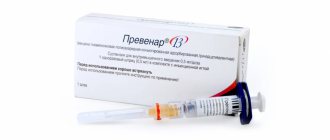Vaccine options
The live attenuated rubella vaccine has been used for more than 40 years. A single dose provides over 95% of long-term immunity, similar to immunity developed as a result of natural infection. Rubella vaccines are either monovalent (a vaccine that targets only one pathogen) or, most often, combined with other vaccines, such as measles (MR), measles and mumps (MMR) or measles, mumps and varicella vaccines. (KSKV). In Russia the following are used: live rubella vaccine, live attenuated rubella vaccine, Priorix, MMR-II.
Purpose
Prevention of rubella.
Routine vaccinations are carried out twice at the age of 12 months and 6 years.
Single vaccination of girls aged 13 years who have not been previously vaccinated and have not had rubella, or girls who have received only one vaccination.
Vaccination against rubella of persons who have not been sick and not previously vaccinated is carried out in accordance with the National Calendar of Preventive Vaccinations of the Russian Federation: children from 5 to 17 years old, girls from 18 to 25 years old.
Vaccinations may also be given to other groups of the population.
Principles and purposes of vaccination
If a woman is infected with the rubella virus early in her pregnancy, she has a 90% chance of transmitting the virus to her fetus. This can lead to miscarriage, stillbirth, or severe birth defects known as CRS. Therefore, prevention of this disease is extremely important. By the end of 2013, rubella vaccine had been introduced nationally in 137 countries.
There are three main approaches to eradicating rubella and CRS: vaccinating children, vaccinating adolescent girls, and vaccinating women of childbearing age who plan to have children. The first strategy is effective against rubella itself, but does not completely solve the problem of CRS (this will require 20-30 years), since, according to available data, vaccination protects for about 20 years, which means that, theoretically, it can shift the incidence of rubella to childbearing years age. The second strategy, vaccinating teenage girls, is effective in eradicating CRS (although it will take 10-20 years to achieve this goal), but does not solve the problem of rubella incidence in general (in Russia, the peak occurs at the age of 7-14 years). Vaccination of women is extremely effective in combating CRS (although achieving 100% coverage of the adult population is almost impossible), but also does not solve the problem of rubella itself.
In view of these considerations, WHO recommends a combination of all three strategies whenever possible. An example of such a combination is the United States, where, in addition to vaccinating children, vaccination is carried out in colleges and the Armed Forces. In accordance with the National Vaccination Calendar, children from 1 to 18 years of age, women from 18 to 25 years of age (inclusive), who have not been sick, not vaccinated, vaccinated once against rubella, and who do not have information about vaccinations against rubella, must be vaccinated. An interesting solution to the problem of vaccinating women of childbearing age was found in France - a refusal to register a marriage in the absence of a stamp of vaccination against rubella or a record of previous infection.
Does a child need vaccinations?
Although rubella is not a fatal disease, there are factors that confirm the need to vaccinate your child. These include:
- If a child is not vaccinated before the age of six, there is a chance that he may develop progressive rubella panencephalitis. The outcome of this disease is fatal.
- In the case of a three-component vaccine, the child will receive protection not only from rubella, but also from measles and mumps, and therefore will not become infected with them, and will not suffer possible complications from diseases.
- Rubella causes serious complications if infected in adulthood. In order to prevent this, it is better to get vaccinated in childhood.
Contraindications
Immunodeficiency conditions; malignant blood diseases and neoplasms. severe reaction (temperature rise above 40 C, swelling, hyperemia more than 8 cm in diameter at the site of vaccine administration) or a complication to the previous dose; acute infectious and non-infectious diseases, exacerbation of chronic diseases - vaccination should be carried out no earlier than 1 month after recovery; pregnancy;
Notes:
- When prescribing immunosuppressants and radiation therapy, vaccination is carried out no earlier than 12 months after the end of treatment;
- HIV - infected children can be immunized with rubella vaccine;
- The vaccine should not be administered during pregnancy. Precautions must be taken to avoid conception for 2 months after vaccination.
How to reduce the likelihood of complications
In order to avoid consequences after vaccination, you should familiarize yourself with the following recommendations:
- If you have any allergic reactions, you should take antihistamines 2-3 days before vaccination. This is a way to reduce the risk of developing infection;
- It is not recommended to eat a lot before vaccination;
- exclude the use of vitamin D 3-4 days before vaccination. You can resume after 5-6 days.
Once the injection has been administered, the person should not immediately leave the medical facility. If the patient suddenly becomes ill and symptoms of adverse reactions appear, it will be better if medical assistance is provided as quickly as possible.
If a person does not have a fever after vaccination, then walking is not contraindicated for him. But it is better not to visit crowded places for several days.
METHOD OF APPLICATION AND DOSAGE
Overdose symptoms have not been established.
Immediately before use, the vaccine is diluted with a solvent (water for injection) at the rate of 0.5 ml of solvent per one vaccination dose of the vaccine. To avoid foaming, the vaccine is dissolved by gently shaking the ampoule. The vaccine should completely dissolve within 3 minutes. The dissolved vaccine is a clear liquid from light yellow to pink. The vaccine and solvent in ampoules with damaged integrity, labeling, or changes in their physical properties (color, transparency, etc.) or improperly stored are not suitable for use.
The opening of ampoules and the vaccination procedure are carried out in strict compliance with the rules of asepsis and antiseptics. The ampoules at the incision site are treated with 70° alcohol and broken off, while preventing alcohol from entering the ampoule. To dilute the vaccine, suck out the entire required volume of solvent and transfer it to an ampoule with dry vaccine. After mixing, the vaccine is drawn into a sterile syringe with another needle and used for vaccination.
The vaccine is administered subcutaneously in a dose of 0.5 ml. in the shoulder area after pre-treating the skin at the site of vaccine administration with 70° alcohol.
The dissolved vaccine is used immediately and cannot be stored.
The vaccination performed is registered in the established registration forms, indicating the name of the drug, date of vaccination, dose, manufacturer, batch number, expiration date, reaction to the vaccination.
Vaccination against rubella: who, when, why?
Basic facts about rubella:
- Rubella is a contagious disease whose only natural host is humans.
- The spread of the disease occurs from a sick person by airborne droplets (droplets containing the virus are released from the respiratory tract of a sick person when coughing, sneezing, or talking).
- For a long time, rubella was considered a variant of measles and only in 1814 was first described in German literature as a separate disease, and therefore previously had a different name “German measles”.
- The viral nature of the disease was established in the early 19th century and it is now known that the disease is caused by the rubella virus (Togavirus).
- In the 40s of the 20th century, a connection was established between rubella contracted during pregnancy and the subsequent birth of children with multiple severe developmental anomalies.
How does rubella occur:
- Rubella in young children often progresses favorably and does not require specific treatment. Typical manifestations are: a slight increase in temperature for several days, a rash (primarily appears on the face and then spreads to the torso and limbs), enlarged and painful lymph nodes, often in the occipital area. And it is very important to note that in this age group, rubella in 25-50% of cases has an erased, inconspicuous or generally asymptomatic course!
- In older children, adolescents and adults, rubella may have more pronounced manifestations in the form of weakness, malaise, and a significant increase in body temperature. The manifestations of the rash and the reaction of the lymph nodes are similar to those of young children. Very often (up to 70% of all cases) girls and young women experience joint pain (arthralgia) and inflammation of the joints (arthritis). Somewhat less often, more serious complications may develop - panencephalitis, purpura, neuritis, orchitis.
What is congenital rubella and why does it need to be considered separately?
- In 1941, Australian ophthalmologist N. Gregg noted an unusually high incidence of congenital cataracts in children born shortly after the rubella epidemic
- Even more revealing were data on morbidity after the rubella pandemic in the United States in 1962-1965. , during which there were 12.5 million cases of rubella and a further 2,000 cases of encephalitis, more than 11,000 spontaneous abortions, 2,100 stillbirths and 20,000 newborns born with congenital rubella syndrome
- Congenital rubella syndrome is a chronic infection that develops in the fetus if the mother becomes ill during pregnancy.
- The severity of the lesion is determined by the period during which the infection occurred. If a pregnant woman falls ill with rubella before the 12th week of pregnancy, then the probability of infection of the fetus is 85%, at 13-16 weeks of pregnancy - 50%. When infected after 18-20 weeks, the risk of congenital anomalies is low, but fetal development is also impaired.
- If rubella infection occurs before 8-10 weeks of pregnancy, a child may be born with severe congenital anomalies, the combination of which is now called the “classic Gregg triad”: deafness, congenital cataracts/glaucoma (up to complete loss of vision) and heart defects. Microcephaly (impaired development of the skull and brain) often occurs. There is a high risk that such a pregnancy will end in spontaneous miscarriage, stillbirth, or premature birth
- If rubella develops in a pregnant woman at a later date, fetal development may be delayed, various organs may be affected - meningoencephalitis, pneumonia, hepatitis, etc.
So what should you do to protect your unborn child?
- The only measure to prevent rubella, including congenital rubella, is vaccination
- The National Immunization Program of the Russian Federation includes vaccination against rubella, which is given to children at 1 year and at 6 years.
- If you did not receive this vaccination as a child, you should receive it at an older age, including in preparation for pregnancy.
Why is vaccination against rubella so important?
- Vaccination against rubella is unusual in its purpose compared to other vaccinations: its main purpose is to prevent congenital rubella!
- We have already decided that rubella in most cases is a harmless and self-limiting disease, BUT! only if it did not develop during pregnancy
- The likelihood that a person with rubella may be near a pregnant woman is high, because It has already been noted above that up to half of all cases of rubella in children can occur with minimal symptoms or asymptomatic
- The highest risk of developing severe pathology in the fetus occurs in the early stages of pregnancy, i.e. for the period when a woman leads an absolutely normal lifestyle for her
Timely vaccination will keep everyone safe!
Currently, a rubella monovaccine and a combined vaccine (measles, mumps, rubella) are registered in the Russian Federation for the prevention of rubella.
Our specialists will inform you about indications, contraindications, features of vaccination, individual regimens, and vaccinations when planning pregnancy.
Sources
https://www.cdc.gov/vaccines/pubs/pinkbook/rubella.html
https://niidi.ru/dotAsset/ba8dd601-7b01-40b6-806c-21bf63436a55.pdf
https://niidi.ru/dotAsset/ba8dd601-7b01-40b6-806c-21bf63436a55.pdf
How to prepare for vaccination?
Vaccination is a responsible process that builds immunity against serious infectious diseases for many years. Before vaccination, you should prepare so that the drug effect takes place as usual and the body receives stable protection for the next 25 years of life. These rules are especially important for children, since not every patient in the younger age group easily tolerates vaccination:
- Before going to the doctor, you should carefully examine the condition of your body, measure your temperature, and check your general health. Make sure that the patient’s immunity is not weakened and is ready for the introduction of measles and mumps strains.
- For children of the younger age group, a preliminary visit to the attending physician is mandatory.
- If you have diseases of the nervous system, prepare anticonvulsants in advance.
- If possible, avoid places with large crowds of people, and visit clinics and hospitals with extreme caution to eliminate the risk of infection of the patient.
Interaction with other drugs
Vaccination against rubella can be carried out simultaneously (on the same day) with other calendar vaccinations (against whooping cough, diphtheria, tetanus, mumps, measles, polio, hepatitis B) or no earlier than 1 month after the previous vaccination. When simultaneous vaccination, drugs are administered to different places; mixing vaccines in one syringe is prohibited.
Immunoglobulins and blood products:
After administration of blood products (immunoglobulin, plasma, etc.), the vaccine is recommended to be administered no earlier than 3 months later. After administration of the rubella vaccine, blood products can be administered no earlier than 2 weeks later; If it is necessary to use immunoglobulin earlier than this period, vaccination against rubella should be repeated after 3 months. If there are antibodies to the rubella virus in the blood serum, repeated vaccination is not carried out.
| Name of service | Price |
| Rubella vaccine (prevention of rubella) | 46 rub. |
What vaccinations are there for measles, rubella and mumps?
All measles, rubella, and mumps vaccines are live attenuated vaccines. This means that the drug contains live viruses grown under artificial conditions and “weakened” in a special way. So that they cannot cause a full-fledged disease, but at the same time they form stable lifelong immunity. Attempts to create inactivated (non-live) vaccines against these infections have been unsuccessful. Such vaccines turned out to be too “weak”, unable to induce lasting immunity.
Among the vaccines are:
— monovaccines. Separately mumps, measles and rubella;
- divaccines. The mumps-measles vaccine is widespread in our country;
- and trivaccines. This group includes the MMP and Priorix vaccines. Such vaccines are preferable because instead of two or three injections, the child receives only one injection.
SIDE EFFECTS
- At the injection site, short-term hyperemia, swelling and induration may sometimes develop, accompanied by pain;
- Skin rash (in the form of small roseola or purple spots of varying sizes);
- A short-term increase in temperature to subfebrile levels; higher temperature in some vaccinated people;
- Lymphadenopathy (enlargement of predominantly occipital and posterior cervical lymph nodes);
- Cough, runny nose, malaise, headache;
- Nausea;
- Arthralgia (in the knee and wrist joints); these reactions occur between 10 and 15 days. after immunization;
- Transient arthritis with and without effusion into the joint cavity;
- Transient polyneuropathy;
- Thrombocytopenic purpura.
All these reactions are characterized by a short-term course and go away without treatment.
Considering the possibility of developing immediate allergic reactions (anaphylactic shock, Quincke's edema, urticaria) in particularly sensitive individuals, vaccinated persons must be provided with medical supervision for 30 minutes. Vaccination sites must be provided with anti-shock therapy.








